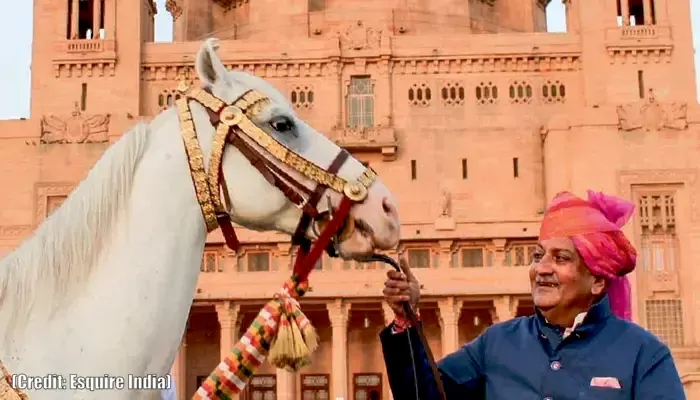
The end of dynasties didn't really end their stories.
There’s always been a certain curiosity about India's royal families. I mean, just how rich were they? What did they eat? How did they live, love, and rule? We’ve read tales of lavish palaces and all. And we’ve also read how those dynasties eventually faded after independence, marking the end of royal privileges. But wait, what happened after that? Where did the royals go when the crowns came off? Well, while not every story has been documented, many royal families in India still exist... just without the official titles. Some have turned to politics, others to business or the arts. A few still live in ancestral palaces, hosting luxury tourists or heritage events.
This article takes you through the lives of India’s former royals today, exploring how they’ve adapted, evolved, and held on to their legacy in a changing world.
In Jaipur, Padmanabh “Pacho” Singh was declared heir after his grandfather’s death in 2011. And today, he is a national‑level polo player, model, and global ambassador for Jaipur heritage. He divides his time between studying overseas, managing heritage ventures like Airbnb stays in City Palace apartments, and championing the Princess Diya Kumari Foundation alongside his mother, MP Diya Kumari.
Estimated family wealth varies widely (from about Rs 4,700 crore to over Rs 20,000 crore), so it’s best understood as a substantial but imprecise range. Behind the glamor, insiders confirm the current strategy is asset-rich but lean on cash flow, with smart reliance on tourism and brand partnerships.

Perched atop Mehrangarh Fort, the Rathore dynasty still commands respect. Maharaja Gaj Singh II transitioned from royal rule to cultural stewardship effortlessly. The Unaid Bhawan Palace is now a private residence, museum, and Taj‑managed hotel, which is quite popular among tourists. Gaj Singh established the Rajmata Krishna Kumari Girls’ Public School and champions events like the Rajasthan International Folk Festival. Local and credible reports peg the family’s assets at an impressive but varied Rs 22,000+ crore.
The Wadiyars traced their roots to Lord Krishna and ran a prosperous kingdom for centuries. Today’s heir, Yaduveer Krishnadatta Chamaraja Wadiyar, became the titular maharaja in 2015 and is now an MP from Mysore (since June 2024).
In his Lok Sabha nomination affidavit, Yaduveer declared total assets just under Rs 5 crore, with no personal land, buildings, or vehicles, and mostly gold, silver, shares, and bonds. The broader family wealth is significant, but Yaduveer personally retains a modest profile.
The Asaf Jahi dynasty once sprawled across a princely empire, with a fortune that legend has could lift cities. The last titular Nizam, Mukarram Jah, passed away in January 2023, having spent much of his life abroad. His son, Azmet Jah, now oversees the family’s palaces (including Chowmahalla and Falaknuma), mostly as heritage sites, along with trust-based educational and healthcare ventures. He carries forward his legacy in a refined, understated way, far removed from public pomp.
Under Sayajirao Gaekwad III, Baroda led social reform and education during British rule. Today, Samarjitsinh Gaekwad, a former Ranji cricketer, lives at Laxmi Vilas Palace, which is now part palace, part tourist spot. His stewardship includes managing large-scale estates, priceless artwork (like Raja Ravi Varma paintings), and public trusts related to education and temples. And the Gaekwad influence now blends civic leadership with cultural stewardship.
The Phulkian family of Patiala once glittered with riches and patronage. Today’s scion, Captain Amarinder Singh, is a former Chief Minister of Punjab, while his children carry forward the public service legacy. Though the old glory of palaces like Moti Bagh evokes grandeur, their financial footprint (a few hundred crores) is modest compared to older claims. Their influence lies more in governance and community work than in jewels or the crown.
Loaded with spiritual wealth, the Travancore family still serves as guardian priests of the Padmanabhaswamy Temple, with its secret vaults reportedly holding treasures worth tens of thousands of crores. Moolam Thirunal Rama Varma, the current head, leads a life of modest hospitality in Thiruvananthapuram, supporting education, music festivals, and temple service.
Claiming descent from Jean-Philippe de Bourbon (a would-be French nobleman), the Bourbons of Bhopal has a quirky tale of European bloodlines in India. The current heir, Balthazar Napoleon IV, works as a lawyer while managing cultural events and ancestral trusts. His claim to the Bourbon name remains genealogical curiosity, not dynastic power, but it adds a rare twist to India’s royal history.
These dynasties are no longer rulers, but their relevance, without an iota of doubt, endure